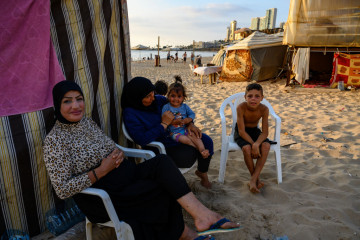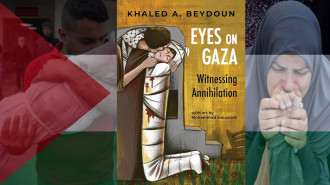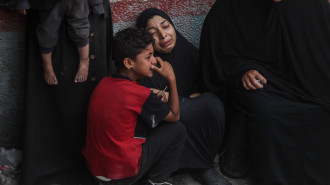

As the sun sets over Beirut's Ramlet El-Bayda beach, the sands that once drew sunbathers and families now host a different crowd: the displaced.
Makeshift tents and huddled groups of people stretch as far as the eye can see, with Syrian refugees forming the majority of the displaced community, having fled not only their war-torn homeland but now also the war Israel has waged on Lebanon.
The internally displaced dot the Lebanese coast from Ramlet El-Bayda and Ain El-Mraiseh to the vicinity of the Beirut International Exhibition & Leisure Center (BIEL), all the way to Martyrs' Square, the courtyards of the Mohammad Al-Amin Mosque, the Hamra neighbourhood, and most of the streets of the capital and its few public gardens.
"We were living in Nabatieh,” Mohammed A., a Syrian father who preferred to remain anonymous, told The New Arab as he sheltered in Ramlet El-Bayda. “When the bombing started, we fled to Beirut but we couldn't afford the inflated rents. Now we're here by the sea, praying for relief from God."
Mohammed explained that a modest apartment would normally cost $150-$200 in rent, but is now between $900 and $1000. “Owners are also asking for five months in advance but if we must evacuate, we would lose this huge amount.”
Like Mohammed, many Syrian refugees find themselves in a precarious situation, unable to return to Syria fearing persecution, mandatory military service, or the prohibitive cost of crossing the border. The Syrian authorities require a $100 entry fee, while those evading military service face fines of up to $8,000.
An all-out war between paramilitary group and political party Hezbollah, and Israel began on September 17 when Israel launched a cyber-attack, simultaneously exploding pager devices of mostly Hezbollah members that left 32 dead and over 3,000 injured, including women and children.
The rapid escalation of violence culminated in the September 28 assassination of Hezbollah's secretary-general Hassan Nasrallah in Beirut's southern suburbs, followed by relentless bombings that have targeted at least 73 paramedics, according to the WHO's representative in Lebanon Dr Abdinasir Abubakar.
According to the Lebanese Ministry of Public Health, at least 2,000 people have been killed, including 127 children and 261 women, with 9,384 injured since the start of the Israeli aggression. The Lebanese Disaster Management Unit reports that the total number of internally displaced persons (IDPs) has reached a staggering 1,200,000.
Nowhere to run
The free public beach at Ramlet El-Bayda, managed by two associations, Cedars for Care and Operation Big Blue (OBB), has become a temporary refuge for IDPs.
Nazih Al-Rayes, a board member of OBB, which also manages the beach, says that OBB immediately offered space at the beach to IDPs.
“The influx here began on September 23. About 400 people are here during the day, but this number almost doubles at night."
Al-Rayes says that about 70 percent of the displaced on the beach are Syrians, as many official shelters and schools do not accept them claiming that they already receive assistance from the UN refugee agency UNHCR. This leaves them particularly vulnerable as winter approaches.
In late September, the agency said that it partnered with the Syrian Arab Red Crescent to provide food, water, blankets and mattresses to thousands of both Lebanese and Syrian IDPs at the border crossing with Syria, noting that the humanitarian situation in Syria remains dire. The 2023 earthquake and the drawn-out conflict in Syria, said the agency, have left critical infrastructure in tatters and millions in need of assistance.
Sanitation at the beach shelters is a primary concern, explained Thierry Goffeau, Field Emergency Coordinator at Médecins Sans Frontières (MSF) in a statement provided to The New Arab via WhatsApp.
"The scale of displacement in Lebanon is unprecedented,” said Goffeau. “When our mobile medical team visited the [Ramlet El-Bayda] beach to provide displaced people with much-needed medical consultations and medication, especially for chronic conditions, they found that people are living without access to basic water and sanitation needs.
"So, we have installed six toilets and 12 showers on the beach, and we plan to install more in the coming days to help maintain hygienic conditions and prevent the spread of diseases," Goffeau added.
"Climatic factors are also working against us,” Jad Al-Rayes, crisis cell official at OBB and disaster management trainer, told The New Arab, “but everyone is holding on to hope."
Food and basic necessities are provided mainly through individual initiatives and small NGOs. Activist Nour Haidar who works with Sam initiative, says their priority now is securing winter clothing and trying to entertain the children.
The Sam initiative began following Lebanon’s October 2019-2020 popular uprising against proposed taxes which quickly spiraled into mass protests opposing the country’s sectarian political system.
“Many people can’t even reach the school shelters and every day there is another displacement to the extent that some people have chosen to stay in their shelled neighbourhoods and homes to preserve their dignity," Haidar told The New Arab. “Nowhere is safe from the bombing.”
Jad Al-Rayes explained that Ramlet El-Bayda beach was set up as a temporary evacuation point for families during raids so that stranded families don’t block roads and hinder ambulances and civil defence, and as a prevention measure for the spread of diseases.
“We worked with the Beirut governorate, keeping families for 24 hours and then directing them to care centres and schools, but on September 27, the displacement was massive," he explains.
"Roads, beaches, and shelters in Mount Lebanon and Beirut were teeming with IDPs,” Al-Rayes added, noting that at one point there were 7,000 people on the beach.
“Our priority was to provide mattresses and blankets, meals, drinking water, and some medicines and painkillers for children and adults. But now we are thinking beyond this, especially with regards to water,” he continued, noting that the environmental toll may lead to a health crisis, which is why they are working on setting up a water filtering system.
Despite the challenges, the spirit of solidarity among volunteers and displaced persons is evident.
"We got to know each other on the ground during the multiple crises Lebanon went through in recent years,” activist and volunteer Sarah Al-Baghdady told The New Arab. “We try to provide two to three meals a day, and basic necessities like formula, diapers and personal care items, all through individual initiatives."
For Syrian refugees like Mariam D., who fled from Baalbek-Hermel in the northern region of Beqaa Valley, the beach is the latest stop in a long journey of multiple displacements.
"Now we are living on the street, in one of the gardens,” said Mariam, who prefers to remain anonymous. “We came to this place with the people who flocked to Ramlet El-Bayda, and we had no other choice."
The UNHCR has indicated plans for the voluntary return of 30,000 displaced Syrians from Lebanon to Syria in the coming period, despite opposition from activist groups that argue that Syria is unsafe.
For many sheltering at this beach, the option to return home remains out of reach.
Suzanne Abou Said is a journalist based in Lebanon
This piece is published in collaboration with Egab






 Follow the Middle East's top stories in English at The New Arab on Google News
Follow the Middle East's top stories in English at The New Arab on Google News


